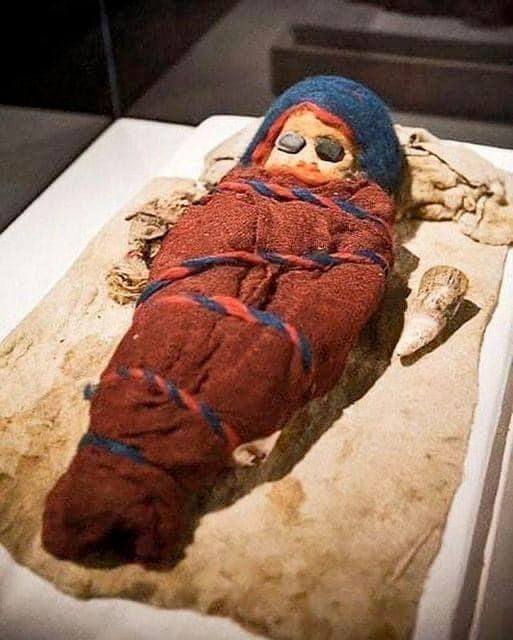This infant, who passed away before reaching the age of one, was found with dark blue stones covering its eyes and red woolen yarn inserted into its nostrils. The burial also included a cow horn tip and a bottle crafted from a sheep’s udder. This remarkably well-preserved infant mummy was discovered in the cemetery of the Qizilchoqa settlement, located approximately 60 kilometers west of Qumul (Hami), an ancient town along the Silk Road situated in the far eastern part of the region. Radiocarbon dating places the burial around 1200 BC.

This discovery is part of a broader archaeological context involving hundreds of Bronze and Iron Age Caucasian (European) mummies unearthed in the deserts along the Silk Road, stretching across Central Asia and Northern China. These findings provide crucial insights into the burial customs, beliefs, and daily lives of ancient cultures that once thrived in this region. Among the grave goods found in infant burials of the Central European Bronze Age Encrusted Pottery culture, which flourished between 2000 and 1500 BC, archaeologists have identified ceramic horns adorned with decorative patterns. These artifacts, found specifically in the graves of infants, suggest a cultural practice aimed at ensuring the deceased children’s sustenance in the afterlife. The placement of these ceramic horns, resembling animal horns, is believed to have served a symbolic purpose—to provide nourishment or drink for the infants as they journeyed into the otherworld. This interpretation stems from the broader funerary practices of the Encrusted Pottery culture, which differentiated burial goods according to the age of the deceased.
Adults were typically interred with large ceramic pots, children with smaller ceramic vessels, and infants with ceramic horns. This age-specific approach to grave goods indicates a deliberate effort to cater to the perceived needs of the deceased in the afterlife, reflecting a belief system that extended beyond death. The notion that the otherworld was considered a “thirsty place” is evident not only in the burial practices of the Encrusted Pottery culture but also in other ancient societies. Providing vessels for liquids, whether water, milk, or other sustenance, was a means of ensuring the deceased’s well-being in the afterlife, where access to essential resources might have been imagined as limited or uncertain. This belief in the necessity of providing for the dead has persisted in various forms throughout history, with echoes still present in certain cultural practices in Central Europe today. The discovery of the Qizilchoqa infant mummy, with its accompanying grave goods, draws intriguing parallels with the burial customs of the Encrusted Pottery culture. The cow horn tip and sheep’s udder bottle may have served a similar purpose as the ceramic horns found in Central Europe—to provide nourishment for the infant’s journey into the afterlife. The use of organic materials, such as the sheep’s udder, reflects the region’s available resources and cultural preferences, while the inclusion of the cow horn tip may have carried symbolic significance related to strength, protection, or sustenance. The presence of dark blue stones covering the infant’s eyes and red woolen yarn inserted into its nostrils further underscores the ritualistic nature of the burial. The placement of stones over the eyes is a practice observed in various ancient cultures, often believed to protect the deceased’s soul or prevent it from returning to the realm of the living.
The use of red woolen yarn may have held symbolic associations with vitality, warmth, or the continuation of life, serving as a means of guiding the infant’s spirit to the afterlife or ensuring its safe passage. The archaeological evidence from both Central Asia and Central Europe highlights the universality of certain beliefs and practices surrounding death and the afterlife. Despite the geographical and cultural differences between these regions, the shared emphasis on providing for the deceased’s needs reflects a common human concern with ensuring the well-being of loved ones beyond death. This cross-cultural resonance underscores the interconnectedness of ancient societies, facilitated in part by trade routes such as the Silk Road, which enabled the exchange of goods, ideas, and beliefs across vast distances. The Silk Road, as a conduit for cultural exchange, may have played a role in the dissemination of certain funerary practices, influencing burial customs in both Central Asia and Europe. The discovery of European-type mummies in the Tarim Basin region further supports the notion of long-distance migrations and interactions between diverse populations, contributing to the region’s rich cultural tapestry. The well-preserved state of the Qizilchoqa infant mummy offers archaeologists a unique opportunity to study the physical and cultural aspects of life in the region during the Bronze Age.
The analysis of textiles, organic materials, and burial artifacts provides valuable insights into the technological capabilities, dietary practices, and spiritual beliefs of the people who inhabited this area. Moreover, the infant’s burial context sheds light on the societal importance placed on honoring and caring for the deceased, even those who died at a very young age. In conclusion, the Qizilchoqa infant mummy represents a poignant testament to the shared human experience of death and the desire to provide for loved ones in the afterlife. The parallels between the burial practices observed in Central Asia and those of the Central European Bronze Age Encrusted Pottery culture highlight the interconnectedness of ancient societies and the enduring nature of certain beliefs. Through archaeological discoveries such as this, we gain a deeper understanding of the cultural and spiritual landscapes that shaped the lives of people along the Silk Road, offering a glimpse into a world where the boundaries between life and death were bridged through acts of care, remembrance, and ritual.





